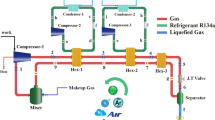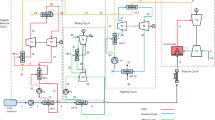Abstract
Today, gas condensate has an important application in industries. One of the high consumption liquid gases is Argon which is used different methods for its liquefaction. However, the costs of this procedure is very high.In this paper, the best cycle from thermodynamic and economic point of view was achieved by thermoeconomic analysis. For this purpose, first, some applicable cycles were investigated and then, liquefying cycle was chosen. In order to optimize cycle, thermoeconomic equations including exergy balance, entropy and energy balance were applied for each component,. Performance coefficient values for dual pressure and pre-heated Linde Hampson cycles are achieved respectively by 2 and 1.8 times multipling by simple cycle. Also, the best performance coefficient of each compressor pressure ratio were evaluated in low ratios, comparing to other pressure ratios. On the other hand, it was illustrated that very low and very high pressure ratios are far from optimum circumstances and just for compressors, the best efficiency can be achieved in relatively low pressure ratios.







Similar content being viewed by others
Abbreviations
- \( {\dot{E}}_P \) :
-
Product exergy flow rate (W)
- c F :
-
Average cost per unit of fuel ($)
- \( {\dot{E}}_{P,k} \) :
-
Kth component product exergy flow rate (W)
- ε k :
-
Kth component exergy efficiency
- \( {\dot{E}}_i \) :
-
Entering rate of exergy transfer (W)
- c i :
-
Average costs per unit of entering exergy ($/GJ)
- \( {\dot{E}}_e \) :
-
Exiting rate of exergy transfer (W)
- c e :
-
Average costs per unit of exiting exergy ($/GJ)
- W:
-
Power (W)
- c w :
-
Average costs per unit of power ($/W)
- \( {\dot{E}}_q \) :
-
exergy transfer rate associated with heat transfer (W)
- c q :
-
Average costs per unit of exergy associated with heat transfer ($/GJ)
- \( {\dot{C}}_F \) :
-
Fuel cost rate ($/h)
- β :
-
Capital recovery factor
- γ :
-
Coefficient of operating & maintanence costs
- I k :
-
Kth component investment cost ($)
- i :
-
Inflation rate
- n :
-
Number of system operating years
- r k :
-
Relative cost difference for Kth component
- f k :
-
Exergoeconomic factor
- \( {\dot{Z}}_k \) :
-
Kth component purchase cost ($)
- τ :
-
Number of system operation hours
- \( {\dot{C}}_L \) :
-
Exergy loss cost rate ($/h)
- \( {\dot{C}}_D \) :
-
Exergy destruction cost rate ($/h)
- CI:
-
Capital investment
- OM:
-
Operation & maintenance
References
Haynes WM (2014) CRC handbook of chemistry and physics. CRC press
Seddon KR, Stark A, Torres MJ (2000) Influence of chloride, water, and organic solvents on the physical properties of ionic liquids. Pure Appl Chem 72(12):2275–2287
Jaluria Y (2007). Design and optimization of thermal systems. CRC press
Bejan A, Tsatsaronis G (1996) Thermal design and optimization. Wiley
Keshavarzian S, Gardumi F, Rocco MV, Colombo E (2016) Off-design modeling of natural gas combined cycle power plants: an order reduction by means of thermoeconomic input–output analysis. Entropy 18(3):71
Li QY, Ju YL (2010) Design and analysis of liquefaction process for offshore associated gas resources. Appl Therm Eng 30(16):2518–2525
Prasad S (2009) Simulation of Nitrogen Liquefication Cycles(Doctoral dissertation)
Remeljej CW, Hoadley AFA (2006) An exergy analysis of small-scale liquefied natural gas (LNG) liquefaction processes. Energy 31(12):2005–2019
Pahl G, Beitz W (2013) Engineering design: a systematic approach. Springer Science & Business Media
de Oliveira, S. (2013). Exergy, exergy costing, and renewability analysis of energy conversion processes. In exergy (pp. 5-53). Springer London
Almeida-Rivera CP, Grievink J (2008) Process design approach for reactive distillation based on economics, exergy, and responsiveness optimization. Ind Eng Chem Res 47(1):51–65
Ahmadi P, Dincer I, Rosen MA (2011) Exergy, exergoeconomic and environmental analyses and evolutionary algorithm based multi-objective optimization of combined cycle power plants. Energy 36(10):5886–5898
Aprea C, Mastrullo R, Renno C (2009) Determination of the compressor optimal working conditions. Appl Therm Eng 29(10):1991–1997
López Paniagua I, Rodríguez Martín J, González Fernandez C, Jiménez Alvaro Á, Nieto Carlier R (2013) A new simple method for estimating exergy destruction in heat exchangers. Entropy 15(2):474–489
Mansouri MT, Ahmadi P, Kaviri AG, Jaafar MNM (2012) Exergetic and economic evaluation of the effect of HRSG configurations on the performance of combined cycle power plants. Energy Convers Manag 58:47–58
Yu J, Tian G, Xu Z (2009) Exergy analysis of joule–Thomson cryogenic refrigeration cycle with an ejector. Energy 34(11):1864–1869
Fang G, Xing L, Yang F, Li H (2005) Exergy analysis of a dual-mode refrigeration system for ice storage air conditioning. Int J Architect Sci 6(1):1–6
Ahmadi MH, Mehrpooya M, Pourfayaz F (2016) Exergoeconomic analysis and multi objective optimization of performance of a carbon dioxide power cycle driven by geothermal energy with liquefied natural gas as its heat sink. Energy Convers Manag 119:422–434
Noroozian A, Mohammadi A, Bidi M, Ahmadi MH (2017) Energy, exergy and economic analyses of a novel system to recover waste heat and water in steam power plants. Energy Convers Manag 144:351–360
Ashouri M, Ahmadi MH, Mohsen Pourkiaei S, Astaraei FR, Ghasempour R, Ming T, Hemati JH (2018) Exergy and exergo-economic analysis and optimization of a solar double pressure organic Rankine cycle. Therm Sci Eng Prog 6:72–86
Ahmadi MH, Sadaghiani MS, Pourfayaz F, Ghazvini M, Mahian O, Mehrpooya M, Wongwises S (2018) Energy and exergy analyses of a solid oxide fuel cell-gas turbine-organic Rankine cycle power plant with liquefied natural gas as heat sink. Entropy 20:484
Author information
Authors and Affiliations
Corresponding author
Additional information
Publisher’s Note
Springer Nature remains neutral with regard to jurisdictional claims in published maps and institutional affiliations.
Rights and permissions
About this article
Cite this article
Dadsetani, R., Sheikhzadeh, G.A., Safaei, M.R. et al. Exergoeconomic optimization of liquefying cycle for noble gas argon. Heat Mass Transfer 55, 1995–2007 (2019). https://doi.org/10.1007/s00231-018-2501-5
Received:
Accepted:
Published:
Issue Date:
DOI: https://doi.org/10.1007/s00231-018-2501-5




